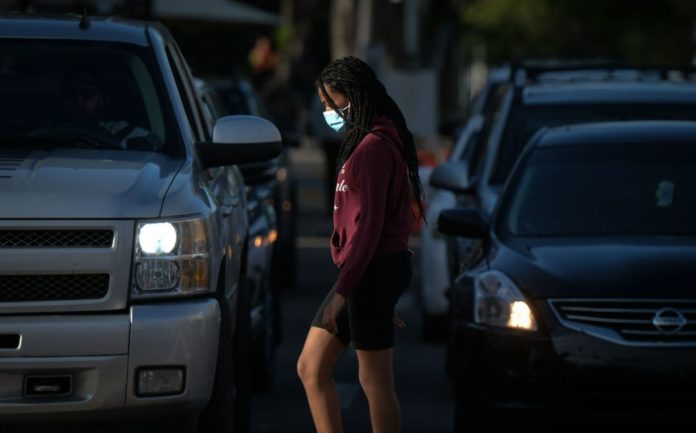Researchers are racing against the clock to discover the biological basis of the highly contagious Delta coronavirus strain, which is wreaking havoc around the world.
Multiple studies have identified an amino acid alteration in Delta that may contribute to the virus’s rapid spread. Epidemiological research indicates that the Delta variant is at least 40 percent more transmissible than the Alpha variant discovered in the United Kingdom in late 2020.
“The key hallmark of Delta is that transmissibility seems to be ramping up to the next notch,” says virologist Pei-Yong Shi.
“We thought Alpha was pretty bad, very good at spreading. This one seems to be even more.”
Shi’s team and others have narrowed the search to a single amino acid change in the SARS-CoV-2 spike protein — the viral component responsible for cell recognition and invasion. The mutation, named P681R, converts a proline residue to an arginine and is located inside a region of the spike protein known as the furin cleavage site.
When SARS-CoV-2 was first identified in China, the presence of this short sequence of amino acids raised alarms because it is associated with increased infectivity in other viruses such as influenza but had not previously been identified in sarbecoviruses, the family of coronaviruses to which SARS-CoV-2 belongs.
“This little insert sticks out and hits you in the face,” says Gary Whittaker, a virologist from Cornell University.
Pre-activated virus
To gain access to cells, the SARS-CoV-2 spike protein must be cut twice by host proteins. Both incisions exist in the SARS-CoV-1 virus that causes severe acute respiratory syndrome (SARS). However, because SARS-CoV-2 contains a furin cleavage site, host enzymes (including one called furin) can make the initial cut as freshly produced virus particles emerge from an infected cell. According to Whittaker, these pre-activated viral particles can then infect cells more efficiently than particles that require two incisions.
Delta was not the first form of SARS-CoV-2 to acquire a mutation altering the furin cleavage site. The Alpha variant contains a distinct amino acid substitution in the same place as the Delta variant. However, the available information indicates that the mutation had a particularly dramatic effect in Delta.
In a study reported as a preprint on 13 August, Shi’s team found that the spike protein is cut much more efficiently in Delta-variant particles than in Alpha particles, echoing results reported in May by virologist Wendy Barclay at Imperial College London and her team, who compared Delta with an earlier strain. Follow-up experiments by both groups showed that the P681R change was largely responsible for spike being clipped so much more efficiently.
In recent research, Shi’s team discovered that the spike protein is cut much more efficiently in Delta-variant particles than in Alpha particles, echoing results reported in May by virologist Wendy Barclay at Imperial College London and her colleagues, who compared Delta to an earlier strain. Follow-up investigations by both groups revealed that the P681R mutation was largely responsible for the spike being clipped so efficiently.
“This really nailed it, in terms of the mechanism,” says Shi.
Researchers are also starting to connect the dots between P681R and Delta’s virulent infectivity. Shi’s team discovered that in cultivated human-airway epithelial cells infected with equal amounts of Delta and Alpha virus particles, Delta quickly outcompeted the Alpha variant, reflecting epidemiological patterns seen around the world. When the researchers removed the P681R modification, Delta’s advantage vanished.
The mutation may also promote the transmission of SARS-CoV-2 from cell to cell. A study lead by Kei Sato, a virologist at the University of Tokyo, discovered that spike proteins with the P681R alteration merge with the plasma membranes of uninfected cells nearly three times faster than spike proteins without the modification.
“I think the virus is succeeding on volume and speed,” says Whittaker. “It’s become a much more efficient virus. It’s going through people and going through cells a lot quicker.”
More than one mutation
Although data suggest that the P681R mutation is a critical component of Delta, experts stress that it is unlikely to be the only mutation responsible for the variant’s rapid dissemination. Delta has a slew of other changes to the spike protein as well as other, less well-studied proteins that could be significant.
“It’s very simplistic to say it’s just this 681 change. I think it’s a sum of everything,” says Teresa Aydillo-Gomez, a virologist from Icahn School of Medicine at Mount Sinai.
According to scientists, the epidemiological and genetic context of the mutation is also key to Delta’s growth. One of Delta’s siblings, a variant named Kappa, was initially detected in India, and possesses several of the same mutations, including P681R, although its effects haven’t been as severe as Delta’s. A team led by structural biologist Bing Chen at Harvard Medical School in Boston, Massachusetts, reports in a preprint published on August 17 that Kappa’s spike protein is cleaved less frequently and fuses to cell membranes far less efficiently than Delta’s. According to the researchers, this discovery calls into doubt the role of P681R.
Researchers in Uganda discovered the P681R alteration in a variant that spread widely in the country in early 2021, but it never took off like Delta did, despite showing many of the same features in cell-based lab research. Whittaker’s team put the P681R mutation into a spike protein from a coronavirus that was circulating in Wuhan, China, during the start of the pandemic and discovered no increase in infectivity.
“It takes more than one mutation to make a difference,” he adds.
Whittaker and other scientists argue that, regardless of its role in Delta’s dominance, the mutation has highlighted the necessity of knowing alterations in the coronavirus’s furin cleavage site. Whittaker believes that P681R will not be the final furin cleavage site mutation to raise concerns.
“I’m waiting to see what happens next.”
Image Credit: GEtty
